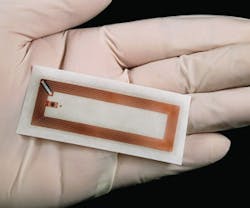Stop intruders at the door without lifting a finger, track your inventory with the click of a mouse, or rig your doors to fly open whenever your company’s CEO rounds the corner. It’s all possible with radio frequency identification (RFID) technology, and it can make your secure areas even more secure with just a few basic pieces of equipment.
A security-savvy manager can even tie in camera movements or alarms to the system, alerting security personnel if, for example, the RFID reader detects two people entering a restricted space, but only one carries a badge that’s valid for that area.
RFID-based security systems eliminate many problems associated with combination locks and swipe cards; namely, that anyone can trade their card or their lock’s combination or allow a non-authorized employee to piggyback on their validated access.
"The problem of the swipe card is tailgating," says Touraj Ghaffari, president and CEO of Florida RFID manufacturer ActiveWave, Inc. "That means if somebody opens the door, and you are behind him and you don’t swipe, the door is open and you can just pass through. With RFID, it generates a field in front of the door. You cannot really pass through the field without detection."
What’s Right for Me?
A solid assessment of your building’s needs is the first step. Decide what you need the RFID system to accomplish and how much you’re willing to spend up front.
Are you replacing traditional locks, photo IDs, or swipe cards with something more secure? A low-frequency (LF) or high-frequency (HF) passive tag has such a low range that the reader must come within about an inch of the tag to read it. The range is so small that an employee merely walking by a door won’t accidentally unlock it and let the wrong person enter a restricted space. These short-range options are "the granddaddies of RFID," says Edmund Rucels, vice president of business development at GAO RFID Inc., an RFID manufacturer in Toronto.
"It’s visibility that you didn’t have before, and that’s what it comes down to on the corporate security level too, is visibility," Rucels says. "It’s who, where, and when. Some people are allowed to be in certain places at certain times."
Maybe you’re moving goods through a building and need to make sure they go to the right places. Choose ultra high frequency (UHF) passive tags, which have a range of around 10 to 16 feet, and pair them with portal readers at each entrance so you can track where in the building that box of PCs is sitting. Use the same spectrum to control access to employee-only parking, assigning every car a unique pass to ensure only your employees can get into your garage.
For more complex solutions, you might need the so-called active tags. These tags come with their own batteries and serve as beacons of sorts, enabling not only a range of up to 328 feet, but many more capabilities. Issue active tags to control which trucks can use your dock or to enable you to communicate with the wearer. Military bases, financial institutions, and other places protecting extremely sensitive information can even add photos, fingerprints, or retinal scans to each tag for an extra layer of protection.
You’ll also need to decide what information to gather, which will determine what software you pair with the tag readers. Depending on your budget, you can have your RFID system record employees’ time and attendance, alert you when someone has spent too much time in a hazmat area, or generate reports for auditing purposes.
As a general rule, the more complex your needs are, the more you’ll spend on software, but bigger systems can bring appealing bulk discounts, according to Don Aviv, a physical security consultant and member of security professional association ASIS International.
"Technology helps," Rucels says. "It’s really an enabler. That’s all RFID is at the end of the day. You don’t see the reader and you almost forget about the tag. It’s the results you’re after. It’s on a computer screen, or you’ve got a safer building. The technology becomes invisible."
Janelle Penny ([email protected]) is associate editor of BUILDINGS.
About the Author
Janelle Penny
Editor-in-Chief at BUILDINGS
Janelle Penny has been with BUILDINGS since 2010. She is a two-time FOLIO: Eddie award winner who aims to deliver practical, actionable content for building owners and facilities professionals.

